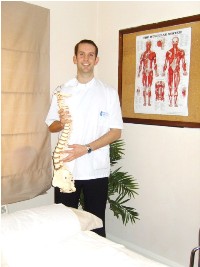What is Osteopathy?
We will be featuring a series of articles with information on how an osteopath could help you with more than just a bad back. Osteopaths have a holistic approach and believe that your whole body will work well if it is in good structural balance.
There is no official set definition of what osteopathy actually is. Many have attempted to answer this question but most in the profession believe that to define it is to put boundaries and limitations on something that cannot be restricted in such a way.
What can be said and what is generally accepted is that osteopathy is a holistic form of manual therapy which helps the body to be more able to heal itself, restoring its balance without the use of drugs or surgery where possible. It is a system of diagnosis and treatment of a huge array of disorders and conditions based upon the fundamental principles created by the founder of osteopathy Dr. Andrew Taylor Still.
Nicholas Coysh BSc (Hons) talks to Kokova Magazine about what osteopathy involves.
Principles of Osteopathy
There are four main principles of osteopathy which were created by its founder Dr. Andrew Taylor. Still at the end of the 19th century, these form the basis of osteopathic thinking and influence their treatment plans.
- The Body is a Unit - the body is considered as a whole, each part affects each and every other part and the whole is greater than just the sum of its parts.
- Structure Governs Function - if the structure of the body is compromised (eg injury, overuse, strain etc.), then it is likely to have an adverse affect on its function (eg pain, stiffness, instability).
- The Body is it's Own Medicine Chest - a person has their own healing mechanisms within which can be stimulated and supported, by removing restrictive barriers to this the body is usually able to resolve all but the most serious of conditions.
- The Rule of the Artery is Supreme - for healing to occur there needs to be a good enough blood supply to provide the area with the necessary immune cells and nutrients.
What Osteopaths Do
Osteopaths adopt a holistic approach to treatment and aim to return the body to optimum performance and what is normal for that patient. Much like a well oiled machine, when the body is structurally balanced and efficient it will function with the minimum of wear and tear, leaving more energy for living. The focus of treatment is not just to target the symptoms alone but to treat the parts of the body that have caused the symptoms.
An Osteopath or a Chiropractor?
Whilst similar in many respects there are subtle differences between an osteopath and a chiropractor.
Similarities
- Both treat similar conditions using similar techniques.
- Both share a common history and philosophy which set them apart from the more traditional allopathic medical fields.
- Their primary objectives are most frequently to relieve aches and pains.
- Both treat more than just bone joints and soft tissues.
- Both work on the nervous system and blood supply to influence all the bodily systems, making them capable of alleviating symptoms of many diagnosed medical conditions such as asthma, stress, digestive disorders, period pain, migraine and more.
- In diagnosing patients both use observation and touch.
Differences
- Osteopathy was founded twenty one years before the chiropractic discipline.
- Chiropractors tend to focus mainly on the alignment of the spine as the primary means to relieve pain by preventing any compromise of the nervous system whereas osteopaths look at the body as a whole and help improve its function by correcting its overall structure.
- Osteopaths treat a broader range of functional problems such as respiratory and digestive system disorders.
- Chiropractors frequently rely on more diagnostic procedures such as X-rays, MRI scans, blood tests and urine tests.
- Osteopaths place more emphasis on the physical examination and will generally refer patients on for more diagnostic procedures if required.
- Osteopaths tend to employ a greater variety of techniques to influence the body's innate healing system such as soft tissue and muscle work, joint articulation and manipulation whereas chiropractors mainly use the "adjustment" on the vertebrae, which is similar to osteopathic manipulation, to permit optimal nerve transition.
- Chiropractic appointments tend to be shorter as they mainly focus on the adjustment techniques which are quick to do.
- Chiropractors tend to see patients more frequently and the muscles tend to pull the misaligned vertebrae out of position again which can take more adjustments for them to settle in position.
- Osteopaths spend more time with their patients per visit as their approach is broader and treatments tend to be spaced out over a longer period of time.
Nicholas Coysh BSc (Hons) Osteopathic Medicine

Treatments at Serendipity, The White Horse and home visits are available 7 days a week, all day and at times to suit you, including early mornings and late evenings.
Advice can also be given over the phone.
For more information about osteopathy, whether it can help you or to book an appointment please contact:
Nicholas Coysh BSc (Hons)
Serendipity Health & Beauty
22a Chipstead Station Parade
Chipstead
Coulsdon
Surrey
CR5 3TE
Clinic: 01737 554 704
Mobile: 07817 934 270
The White Horse Hotel
Storrington,
West Sussex
RH20 4DJ
Tel: 01903 745831